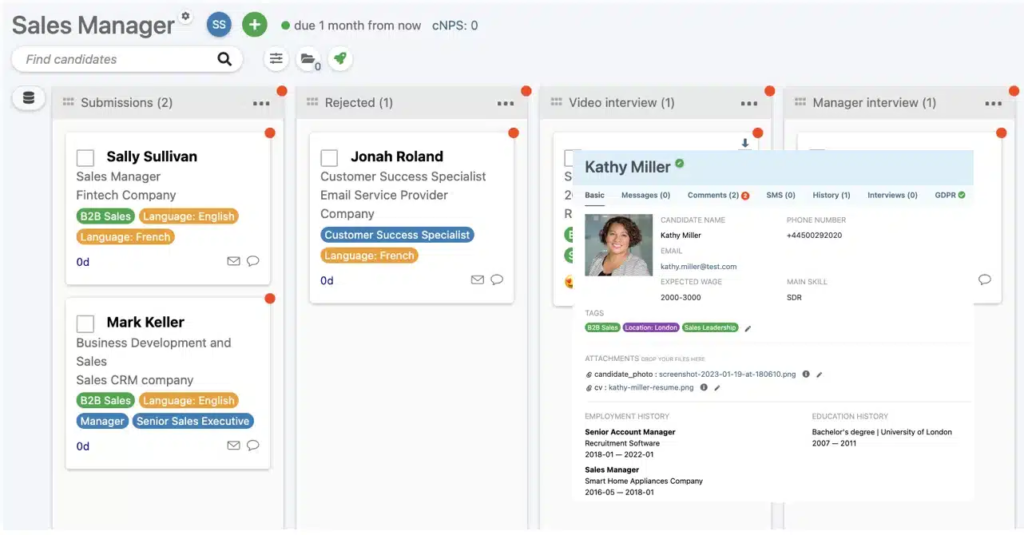What is talent sourcing?
Talent sourcing is the process of finding, attracting, and engaging individuals who have the potential to fill roles within a company. It’s a proactive approach to hiring that focuses on building relationships with potential candidates, sometimes even before a role is open.
In today’s highly competitive talent market, searching for the ideal candidate is harder than ever. Simply placing your job advert on local job boards won’t cut it anymore. Instead, forward-thinking businesses are focusing on their talent pipeline as part of their hiring process, and building relationships with potential candidates through powerful – and flexible – talent sourcing strategies.
There are several methods of talent sourcing, including:
1. Networking: This can involve attending industry events, conferences, meet-ups, and other gatherings to meet potential candidates.
2. Social media: Sites like LinkedIn, Twitter, and Facebook are commonly used for sourcing talent. Recruiters often search for candidates with specific skills and backgrounds, and reach out to them directly.
3. Employee referrals: Current employees often have large networks and can refer potential candidates to the company. Learn more about the advantages and disadvantages of internal recruitment.
4. Job boards and career sites: Many recruiters post open positions on job boards and career sites to attract candidates.
5. Recruiting agencies: Some companies outsource their recruiting efforts to agencies that specialise in finding and attracting talent.
6. Talent pools: Companies often maintain a database of potential candidates who have expressed interest in working for the company or have applied in the past.
7. Headhunting: This is a more direct approach where recruiters actively reach out to individuals (usually for more senior roles) to gauge their interest in a position.
8. University recruiting: Many companies have programs dedicated to hiring recent graduates or interns.
While these methods can be used to find candidates for a current opening, the focus in talent sourcing is on building a pipeline of potential candidates for future needs. This proactive approach can make the hiring process quicker and more efficient when a role does open up.

What is the talent sourcing process?
All businesses say that they are looking for top talent! So yours really needs to find its edge to secure the best possible candidates. A talent sourcing strategy requires working through a systemised process in order to create a robust, measurable recruitment approach that yields the results.
It’s usually delivered with the assistance of an Applicant Tracking System, or ATS to unlock the best results and to maximise efficiencies. At a high level, it involves the following stages:
1. Defining needs
Understand what your business needs in terms of skills, values, and attributes. Focus on diversity! Then consider what you need to offer to the right candidate in order to attract them into your business. The needs definition stage gives you a clear brief and sets the direction of your work.
2. Creating candidate personas
For specific roles, it’s vital to build a candidate persona in the way that sales would develop customer personas. Recruitment and HR functions can – and should – work with hiring managers to understand what kind of person would really excel in the role they want to fill, and the team that they’d be working in. These conversations will create a meaningful persona that will guide interviews and hiring decisions.
3. Engaging and connecting with candidates
During recruitment, you’ll make contact with any individuals who appear to be a good fit for your business, and interview potential candidates to get to know them. This involves connecting with your target candidates on the platforms they prefer to use. Most recruiters automatically think of LinkedIn, but there are plenty of other networks and groups that exist for professions, groups, and interests. Read more about social recruiting.
Think outside the box to access the great talent that might not even be looking for a new role. You might be able to access these individuals via referrals, conversations, or industry events, for example.
4. Closing the recruitment loop
When a candidate (or candidates) are shortlisted and accept your job offer, you move towards onboarding. At this stage, it is also vital to gather feedback on your talent sourcing process and communicate proactively with unsuccessful candidates to nurture them for future potential roles. This stage is often overlooked, but proactive, friendly, and meaningful communications with unsuccessful candidates can transform them into engaged advocates of your business – and potential future hires. Even a simple thing like a personalised rejection email can help keep the door open for future.

6 powerful talent sourcing strategies to try
So what kinds of talent sourcing strategies tend to translate to success? These are all worth taking forward:
1. Develop your employer brand
Your company culture is a key driver of talent acquisition and retention. Simply put, great people want to work – and progress – at companies they feel aligned with. Simply advertising a good salary doesn’t cut it nowadays, especially for younger workers. Talented individuals want to know what your business values and ethos are. They want to understand the opportunities for challenge, development, and progression. They need to know what you stand for and feel a connection to this purpose. Your job is to develop an employer brand that captures these attributes and communicates them in a compelling way to your target job-seeker audience.
2. Use your employee network
Your existing employees are another powerful network that you must leverage to build your talent pool. Existing employees – if they are satisfied at work – will recommend your business to their own friends and networks. Talented individuals that fit culturally within your organisation are likely to know other people who have the same kind of potential fit. Incentivise your employees in some way to refer in potential job applicants, and you have a powerful channel of leads that can be nurtured through your talent processes. Internal recruitment has many advantages but also some disadvantages to be aware of.
3. Focus on your flow
The ideal scenario is to have a consistent flow of highly qualified candidates that stay active and nurtured within your talent pool. Build this pool of talent, nurture it with engaging communications and opportunities, and always circle back to candidates that apply to a role to update them on the process and provide feedback at key stages (including candidates who aren’t successful. They will be far more likely to apply for a subsequent role at your firm if they have a positive experience with your talent sourcing and recruitment processes from the first contact.)
4. Review your recruitment process
Modern candidate sourcing strategies need to be slick, multi-channel, and integrated for maximum effect. Your talent sourcing strategies must have the same visual appeal and powerful messaging as your business marketing and sales campaigns. With that in mind, take care of the details. Respond to reviews, build your social media presence, perfect your messaging, and tell your story.
5. Build a talent pool for jobs you don’t have yet
Modern recruitment endeavours to have candidates ready and waiting for roles even before they are advertised. Some businesses have cyclical recruitment needs that make these roles relatively easy to forecast. But even if your business isn’t cyclical in its hiring, you can use succession planning strategies to identify where new roles are likely to emerge within your organisation, and when they are likely to come up. By planning in this way, you can nurture your candidate pool through early engagement stages so that they are highly motivated and ready to apply when the right role comes up.
6. Develop your ATS talent pool
An Applicant Tracking System (ATS) can help you to optimise your recruitment by streamlining your processes and aligning them to your HR function. This is a particularly valuable piece of software for growing businesses. ATS systems help to:
- Streamline recruitment processes so that businesses secure the talent that they need faster, and with less waste. Save up to 70% of your time hiring
- Automate manual tasks up HR to free up recruitment time for higher-value tasks
- Improve quality of hire by helping to match open roles to registered candidates
These powerful systems can greatly boost quality outcomes, whilst cutting waste and costs, resulting in a more efficient, successful business with the ability to run a modern, evolving recruitment function. If you’re serious about developing a powerful sourcing strategy, an ATS will invariably underpin it.

ATS systems to build your business talent sourcing
At Teamdash, we offer a highly customisable ATS built by recruiters for recruiters. Our ATS systems are designed to deliver transformational benefits to forward-thinking businesses in a changing world, and they flex to business needs, whatever the industry and requirements.
With Teamdash you can:
- Design attractive job ads and landing pages without the help of a designer
- Automatically post on job boards and other sourcing channels
- Visualise your progress with customisable recruitment projects
- Create custom pipelines, triggers and automations
- Keep your talent pool in one place and GDPR compliant
And much more!
Teamdash – The all-in-one recruitment software.
Streamline your recruitment process, save up to 70% of your time and hire top talent fast.



